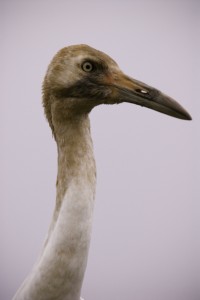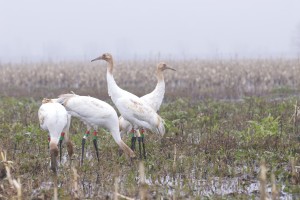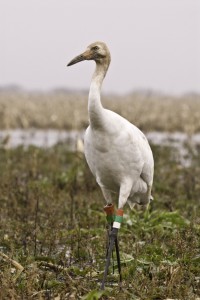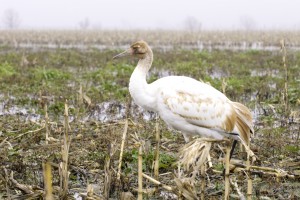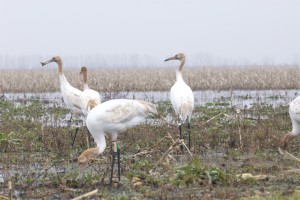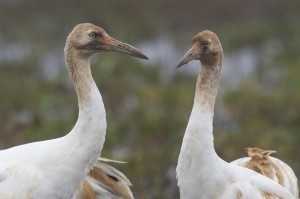They ARE Whoopers!
Dimly seen through a dreamlike fog and mist, the six huge birds are unmistakably, absolutely, incontrovertibly juvenile Whooping Cranes: five-foot tall, white-splotched-with-brown, black-tipped-winged wonders and the rarest bird species in North America.
What are they doing in Monroe County? That, is, besides wading and eating the occasional frog or bite of corn as they slowly coursed across the wetland. The greater Mississippi River flyway hosts numerous species of birds, but while Whooping Cranes may have a deep, species-memory of wetland haunts along the river, they have not regularly been here for nearly two centuries.
Whooping Cranes, one of North America’s rarest, largest and most magnificent birds, are relicts from the past. They are absolutely intolerant of human ‘progress.’ They, as Peter Matthiessen, the renowned nature writer, noted, evoke our misgivings on retreating wilderness. Revered by Amerindians, crane calls were viewed as the voice of nature. Native Americans called them the “Echo Makers” and “Speakers for the Clans.”
The historical breeding range of Whooping Cranes extended from
Illinois northward and northwestward into Canada. Their wintering ranges were the highlands of Mexico and the U.S. Gulf and Atlantic seaboards. Whooping Cranes were, and are, uncompromisingly dependent on pristine wetland habitats.
Whooping Cranes were never very abundant; they are the rarest of the 15 worldwide species of cranes. Their pre-European settlement population in North America is estimated at only 15,000. By the 1860s their population dwindled to 1400, and in the 1940s plummeted to about a dozen birds.
John James Audubon observed a whooper near Massac County in 1819. They occasionally were seen in Illinois until 1891. A lone accidental sighting, with photograph, was recorded in Pike County in 1958.
Today whoopers are slowly rebounding, with a wild population nearing 600 cranes. The largest population breeds in Wood Buffalo National Park in Canada and winters at Aransas National Wildlife Refuge in Texas.
Over the last two decades, the Whooping Crane Eastern Partnership, a coalition of nine private and governmental agencies, has been trying to establish a second population of Whooping Cranes. The overall program goal is to establish a self-sustaining Eastern U.S. flock with a minimum of 125 birds including 25 breeding pairs. Hatching eggs, then raising Whooping Crane chicks to fledgling age is done in a carefully controlled manner by costumed and silent workers in order to minimize the risks that the birds will imprint on humans rather than their own kind. Teaching the birds to migrate posed an even greater puzzle.
The inspired solution was to train the birds to follow an ultralight aircraft. An initial experimental effort conducted with Canada Geese in 1994, and depicted in the popular Columbia Pictures film “Fly
Away Home,” led to further trials with Sandhill Cranes. The first ultralight-led Whooping Crane assisted migration took place in autumn of 2001, with a flight path from National Wildlife Refuges in Necedah, WI to Chassahowitza, FL. In the first five years of this program, 60 birds have been taught the flight path — four times the number of Whooping Cranes that existed in the 1940s.
With adult birds now proceeding on their own along the migration path, a second effort for migration teaching was devised in 2005, with the U.S. Fish and Wildlife Service the lead agency among the WCEP partners for this plan. In this case, fledgling birds are released to follow along with the adults. This Direct Autumn
Release program resulted in the successful migration of four juveniles each year in 2005 and 2006. This year 10 juveniles were slated for the DAR program while 17 other juvenile birds participate in the ongoing ultralight-led migration program.
Crane disdain for human innovation proved itself again on November 6, 2007.
Six juvenile whoopers in the DAR program broke ranks with their adult-led flock and headed south for Illinois. After numerous several-day stopovers in upstate Illinois, the recalcitrant six-some landed in the American Bottoms of Monroe County Illinois.
On the bed of ancient Kidd Lake Marsh, APH Inc., a private conservation club, and Kidd Lake Marsh State Natural Area together provide superb habitat in a 650-acre wetlands restoration. The six whoopers luxuriated there from December 7th to the 11th. On the 11th, U. S. FWS personnel captured the birds and they began their long drive to the Florida wintering grounds.
In the spring the birds will accompany the adults of the flock and return to Wisconsin. As they fly the birds call to each other, keeping the flock together and on course. To hear those calls, conservationist Aldo Leopold said, is “to hear the trumpet in the orchestra of evolution.” Once back on the breeding grounds, the young cranes also will learn the complex choreography of crane dancing as birds pair bond before mating. And, perhaps, when they have matured and lead their own young on migration, they will remember and return to rich wetland habitats in Monroe County.
Perhaps some day we will hear the bugling calls of Whooping Cranes along restored wetlands in Illinois’ Mississippi River flyway.
CLIFFTOP, a local nonprofit organization of landholders, is focused on preserving and protecting area bluff lands.
Versions of this article appeared in the Winter 2007-2008 edition of Illinois Audubon Magazine, published by the Illinois Audubon Society, Springfield, IL and in the Spring 2008 edition of Mews News, published by the World Bird Sanctuary, Valley Park, MO.
© 2007 all content rights reserved, Clifftop NFP.
Comments are currently closed.

